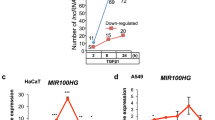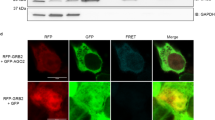Abstract
MicroRNAs (miRNAs) are single-stranded regulatory RNAs, frequently expressed as clusters. Previous studies have demonstrated that the six-miRNA cluster miR-17∼92 has important roles in tissue development and cancers. However, the precise role of each miRNA in the cluster is unknown. Here we show that overexpression of miR-17 results in decreased cell adhesion, migration and proliferation. Transgenic mice overexpressing miR-17 showed overall growth retardation, smaller organs and greatly reduced haematopoietic cell lineages. We found that fibronectin and the fibronectin type-III domain containing 3A (FNDC3A) are two targets that have their expression repressed by miR-17, both in vitro and in transgenic mice. Several lines of evidence support the notion that miR-17 causes cellular defects through its repression of fibronectin expression. Our single miRNA expression assay may be evolved to allow the manipulation of individual miRNA functions in vitro and in vivo. We anticipate that this could serve as a model for studying gene regulation by miRNAs in the development of gene therapy.
This is a preview of subscription content, access via your institution
Access options
Subscribe to this journal
Receive 12 print issues and online access
$209.00 per year
only $17.42 per issue
Buy this article
- Purchase on Springer Link
- Instant access to full article PDF
Prices may be subject to local taxes which are calculated during checkout





Similar content being viewed by others
References
Lim, L. P., Glasner, M. E., Yekta, S., Burge, C. B. & Bartel, D. P. Vertebrate microRNA genes. Science 299, 1540 (2003).
Lee, Y. et al. The nuclear RNase III Drosha initiates microRNA processing. Nature 425, 415–419 (2003).
Ota, A. et al. Identification and characterization of a novel gene, C13orf25, as a target for 13q31-q32 amplification in malignant lymphoma. Cancer Res. 64, 3087–3095 (2004).
He, L. et al. A microRNA polycistron as a potential human oncogene. Nature 435, 828–833 (2005).
Hayashita, Y. et al. A polycistronic microRNA cluster, miR-17-92, is overexpressed in human lung cancers and enhances cell proliferation. Cancer Res. 65, 9628–9632 (2005).
Landais, S., Landry, S., Legault, P. & Rassart, E. Oncogenic potential of the miR-106-363 cluster and its implication in human T-cell leukemia. Cancer Res. 67, 5699–5707 (2007).
Petrocca, F. et al. E2F1-regulated microRNAs impair TGFβ-dependent cell-cycle arrest and apoptosis in gastric cancer. Cancer Cell 13, 272–286 (2008).
Koralov, S. B. et al. Dicer ablation affects antibody diversity and cell survival in the B lymphocyte lineage. Cell 132, 860–874 (2008).
Sylvestre, Y. et al. An E2F/miR-20a autoregulatory feedback loop. J. Biol. Chem. 282, 2135–2143 (2007).
Mendell, J. T. miRiad roles for the miR-17-92 cluster in development and disease. Cell 133, 217–222 (2008).
O'Donnell, K. A., Wentzel, E. A., Zeller, K. I., Dang, C. V. & Mendell, J. T. c-Myc-regulated microRNAs modulate E2F1 expression. Nature 435, 839–843 (2005).
Dews, M. et al. Augmentation of tumor angiogenesis by a Myc-activated microRNA cluster. Nature Genet. 38, 1060–1065 (2006).
Zhang, L. et al. microRNAs exhibit high frequency genomic alterations in human cancer. Proc. Natl Acad. Sci. USA 103, 9136–9141 (2006).
Ivanovska, I. et al. MicroRNAs in the miR-106b family regulate p21/CDKN1A and promote cell cycle progression. Mol. Cell Biol. 28, 2167–2174 (2008).
Lu, Y., Thomson, J. M., Wong, H. Y., Hammond, S. M. & Hogan, B. L. Transgenic over-expression of the microRNA miR-17-92 cluster promotes proliferation and inhibits differentiation of lung epithelial progenitor cells. Dev. Biol. 310, 442–453 (2007).
Matsubara, H. et al. Apoptosis induction by antisense oligonucleotides against miR-17-5p and miR-20a in lung cancers overexpressing miR-17-92. Oncogene 26, 6099–6105 (2007).
Ventura, A. et al. Targeted deletion reveals essential and overlapping functions of the miR-17 through 92 family of miRNA clusters. Cell 132, 875–886 (2008).
Xiao, C. et al. Lymphoproliferative disease and autoimmunity in mice with increased miR-17-92 expression in lymphocytes. Nature Immunol. 9, 405–414 (2008).
Fontana, L. et al. MicroRNAs 17-5p-20a-106a control monocytopoiesis through AML1 targeting and M-CSF receptor upregulation. Nature Cell Biol. 9, 775–787 (2007).
Ye, W. et al. The effect of central loops in miRNA:MRE duplexes on the efficiency of miRNA-mediated gene regulation. PLoS ONE 3, e1719 (2008).
Wang, C. H. et al. MicroRNA miR-328 regulates zonation morphogenesis by targeting CD44 expression. PLoS ONE 3, e2420 (2008).
Hossain, A., Kuo, M. T. & Saunders, G. F. Mir-17-5p regulates breast cancer cell proliferation by inhibiting translation of AIB1 mRNA. Mol. Cell Biol. 26, 8191–8201 (2006).
Wang, Q. et al. miR-17-92 cluster accelerates adipocyte differentiation by negatively regulating tumor-suppressor Rb2/p130. Proc. Natl Acad. Sci. USA 105, 2889–2894 (2008).
Gregory, P. A. et al. The miR-200 family and miR-205 regulate epithelial to mesenchymal transition by targeting ZEB1 and SIP1. Nature Cell Biol. (2008).
Rybak, A. et al. A feedback loop comprising lin-28 and let-7 controls pre-let-7 maturation during neural stem-cell commitment. Nature Cell Biol. 10, 987–993 (2008).
Naguibneva, I. et al. The microRNA miR-181 targets the homeobox protein Hox-A11 during mammalian myoblast differentiation. Nature Cell Biol. 8, 278–284 (2006).
Johnnidis, J. B. et al. Regulation of progenitor cell proliferation and granulocyte function by microRNA-223. Nature 451, 1125–1129 (2008).
Jiang, G., Giannone, G., Critchley, D. R., Fukumoto, E. & Sheetz, M. P. Two-piconewton slip bond between fibronectin and the cytoskeleton depends on talin. Nature 424, 334–337 (2003).
Rifes, P. et al. Redefining the role of ectoderm in somitogenesis: a player in the formation of the fibronectin matrix of presomitic mesoderm. Development 134, 3155–3165 (2007).
Karaulanov, E. E., Bottcher, R. T. & Niehrs, C. A role for fibronectin-leucine-rich transmembrane cell-surface proteins in homotypic cell adhesion. EMBO Rep. 7, 283–290 (2006).
Georges-Labouesse, E. N., George, E. L., Rayburn, H. & Hynes, R. O. Mesodermal development in mouse embryos mutant for fibronectin. Dev. Dyn. 207, 145–156 (1996).
Lee, D. Y., Deng, Z., Wang, C. H. & Yang, B. B. MicroRNA-378 promotes cell survival, tumor growth, and angiogenesis by targeting SuFu and Fus-1 expression. Proc. Natl Acad. Sci. USA 104, 20350–20355 (2007).
Lee, D. Y. et al. A 3'-untranslated region (3'UTR) induces organ adhesion by regulating miR-199a* functions. PLoS ONE 4, e4527 (2009).
Sheng, W. et al. The roles of versican V1 and V2 isoforms in cell proliferation and apoptosis. Mol. Biol. Cell 16, 1330–1340 (2005).
Sheng, W. et al. Versican mediates mesenchymal-epithelial transition. Mol. Biol. Cell 17, 2009–2020 (2006).
Yee, A. J. et al. The effect of versican G3 domain on local breast cancer invasiveness and bony metastasis. Breast Cancer Res. 9, R47 (2007).
LaPierre, D. P. et al. The ability of versican to simultaneously cause apoptotic resistance and sensitivity. Cancer Res. 67, 4742–4750 (2007).
Hua, Z. et al. MiRNA-Directed Regulation of VEGF and Other Angiogenic Factors under Hypoxia. PLoS ONE 1, e116 (2006).
Acknowledgements
We thank J. Ma for assistance in real-time PCR experiments, G. Knowles for flow cytometry analysis at the Core Facilities of Sunnybrook Research Institute, S. Gatchell and K. Green for the generation and maintenance of transgenic mice at UWO, D. Wei for technical assistance in molecular cloning, and J. Yang for editing the manuscript. This work was supported by a grant (NA 6282) and a Career Investigator Award (CI 5958) from Heart and Stroke Foundation of Ontario to B.B.Y. and a China-Canada Joint Health Research Grant (from Canadian Institutes of Health Research and the National Natural Science Foundation of China to B.B.Y. and Y.Z.). D.Y.L. is the recipient of a Canada Graduate Scholarship.
Author information
Authors and Affiliations
Contributions
S.W.S. generated expression constructs, performed the in vitro cell activity assays including western blot analysis, RT-PCR and northern blots, and was involved in writing the related method sections; D.Y.L. performed genotype analysis, RT-PCR, northern blots, organized/prepared animal samples, assisted in B-cell FACS analysis, and was involved in tissue collection and in writing the related method sections; Z.D. was involved in organizing animal samples, performed RT-PCR, real-time PCR, and RNase-protection assays; T.S. designed bone marrow and lymph node B-cell experiments, performed bone marrow B-cell FACS analysis and immunohistochemistry, and was involved in writing the related methods; Z.J. performed luciferase activity assays; W.W.D. was involved in western blot analysis; Y.Z. provided analytical tools; J.W.X. was involved in mouse dissection analysis; S.P.Y. oversaw the generation of transgenic mice and was involved in writing the methods; V.S. designed and performed spleen B-cell experiments; B.B.Y. directed the research, designed and coordinated the project, analysed the data, and wrote the manuscript.
Corresponding author
Ethics declarations
Competing interests
The authors declare no competing financial interests.
Supplementary information
Supplementary Information
Supplementary Information (PDF 1100 kb)
Rights and permissions
About this article
Cite this article
Shan, S., Lee, D., Deng, Z. et al. MicroRNA MiR-17 retards tissue growth and represses fibronectin expression. Nat Cell Biol 11, 1031–1038 (2009). https://doi.org/10.1038/ncb1917
Received:
Accepted:
Published:
Issue Date:
DOI: https://doi.org/10.1038/ncb1917
This article is cited by
-
Linking RNA dynamics to heart disease: the lncRNA/miRNA/mRNA axis in myocardial ischemia–reperfusion injury
Hypertension Research (2022)
-
miR17~92 restrains pro-apoptotic BIM to ensure survival of haematopoietic stem and progenitor cells
Cell Death & Differentiation (2020)
-
MiR-17 and miR-19 cooperatively promote skeletal muscle cell differentiation
Cellular and Molecular Life Sciences (2019)
-
MiRNA-17 encoded by the miR-17-92 cluster increases the potential for steatosis in hepatoma cells by targeting CYP7A1
Cellular & Molecular Biology Letters (2018)
-
Functional similarities of microRNAs across different types of tissue stem cells in aging
Inflammation and Regeneration (2018)



